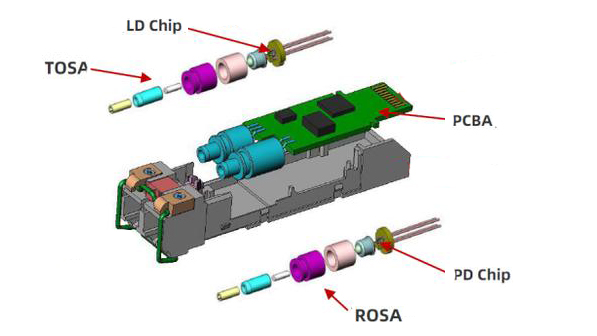When it comes to optical fibers, you might only be familiar with fiber optic cables, but there's another crucial component in the process of fiber transmission – optical modules. Today, let's take a quick look at what optical modules are.
To enable fiber optic communication, it's necessary to perform optical-to-electrical conversion, i.e., converting optical signals into electrical signals or vice versa. During this process, optical modules (Optical Module) serve as the "converter."

An optical module typically consists of a transmitter optical subassembly (TOSA), a receiver optical subassembly (ROSA), functional circuits, and optical/electrical interfaces. It resembles a USB flash drive in appearance. To use it, you simply install the optical module into the corresponding port of the device, secure the latch, and connect the fiber optic patch cord at the interface to enable fiber transmission.

Understanding the function and usage of optical modules is straightforward, but what truly boggles the mind is their diverse range of types and parameters. Due to the rapid pace of fiber optic communication development, new form factor standards (enclosures) for optical modules are introduced every few years. Additionally, the versatile applications of fiber optics require different types for varying transmission distances, bandwidth requirements, and environmental settings, contributing to the increased diversity of optical modules.

Currently, common optical module form factor types include the SFP series and QSFP series. SFP (Small Form-Factor Pluggable) is a compact, hot-swappable optical module that supports bandwidths ranging from 1G to 100G. Meanwhile, QSFP (Quad Small Form-Factor Pluggable) offers four channels, capable of achieving a maximum bandwidth of 800G.


Apart from form factor types, optical module parameters also include speed, wavelength, distance, and interfaces, among others. These parameters provide optical modules with greater flexibility and scalability in different scenarios, thereby meeting various requirements.

Today, optical modules have become indispensable. With the rise of 5G and AI, the massive demand for computing power relies heavily on the support of optical modules. Behind the ever-evolving digital world lies the iterative updates of technology. As a vital component of fiber optic communication, optical modules will see even broader applications in the future.
















